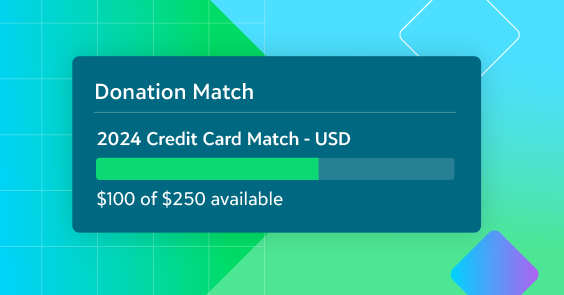Best Practices for Multiplying Impact With Matching Gifts

Matching gift programs, in which companies financially match employee donations to nonprofit organizations, can be an incredible way to amplify the impact of charitable contributions. In fact, research on the topic showed that 84% of survey participants say they’re more likely to donate if a match is offered, and 1 out of 3 say indicate they’d give a larger gift if matching is applied to their donation.
These programs not only enhance the company’s philanthropic footprint but also incentivize a culture of giving among employees. Let’s explore the best practices for setting up and managing matching gift programs, promoting them effectively, and leveraging tools like YourCause CSRconnect to maximize their impact.
Setting Up Parameters and Eligibility Criteria
Deciding Your Matching Budget
The first step in establishing a matching gift program is determining the budget. This will allow you to set a total match cap per employee per year. For reference, 80% of companies’ matching gift maximums fall between $500 and $10,000 annually per employee. Consider the following factors:
- Company Size and Financial Health: Assess the scale of your available resources. Larger companies or those with larger financial capacity may be able to allocate more substantial budgets.
- Employee Participation Rates: Estimate the potential participation rate based on past engagement in charitable activities. Use this to predict an approximate budget for various match caps.
- Strategic Goals: Align the budget with the company’s CSR goals and overall mission. Are there donation goals you are trying to achieve? Is employee giving engagement a priority that could be boosted by a greater matching incentive?
Matching Eligibility Criteria
Defining clear eligibility criteria ensures the program is fair and manageable. Key considerations include:
- Types of Charities/Causes: Decide which types of organizations will be eligible for matching. Are there types of nonprofits or cause areas that your company wouldn’t want to match donations towards? Ensure the chosen causes align with your company’s values and CSR strategy but note thatmore charities eligible for matching often leads to greater use of the incentive.
- Types of Employees: Determine which employees are eligible to participate. The most common option for segmentation is with full-time employees, part-time employees, contractors, and retirees. Each group may have different matching limits or criteria. This could also include specific types of employees based on an HR attribute so that you can target matching programs to certain departments, for example.
- Geographical Scope: Consider whether the program will be available to employees in all locations or limited to partiucular regions. This decision may depend on the company’s global presence and the administrative complexity of managing a worldwide program.
Promoting and Communicating the Program
Effective communication is essential to maximizing employee participation in matching gift programs and CSR programs in general. Here are some effective strategies:
Comms Strategy
- Multi-Channel Approach: Use a variety of communication channels, including email, intranet, social media, and company meetings, to reach all employees. A message from the CEO or senior leaders can be helpful to highlight the value of the program and rally employees. Including information to new hires can also get them engaged early.
- Clear Messaging: Ensure that all communications clearly explain the program’s benefits, eligibility criteria, and how to participate.
Outlining the Details
- Step-by-Step Guides: Provide detailed instructions on how to submit matching gift requests. Visual aids like infographics or video tutorials can be particularly helpful.
- FAQs: Create a comprehensive FAQ section to address common questions and concerns.
Incentivizing Employees
- Recognition Programs: Spotlight employees or departments who have high participation rates within newsletters or team meetings. Call out the increased impact of the matched donations in supporting the important causes.
- Matching Cap Awareness: Encourage employees to maximize their contributions by calling out the annual matching cap and reminding them of any deadlines.
Ideas for Unique Matching Programs
To keep the program engaging and relevant, consider implementing unique matching initiatives:
- Increased Matching for Special Occasions: Offer higher matching rates for donations made during specific times, such as disaster relief efforts, marketing campaigns, Giving Tuesday or company anniversaries. To learn more about aligning CSR campaigns around moments that matter, download our full checklist.
- Themed Marketing Campaigns: Organize themed giving marketing campaigns that align with current events or company milestones/achievements.
Leveraging CSRconnect to Implement and Measure Impact
CSRconnect is a powerful tool for managing matching gift programs and measuring their impact. Here’s how to make the most of it:
Implementation
- Centralized Platform: Use CSRconnect to centralize all matching gift requests and approvals, making the process seamless for both employees and administrators.
- Automated Processes: Leverage automation features to streamline the submission and matching process, reducing administrative burden. Match approvals can be helpful to ensure that your matching policy is being followed, but it does require extra time and oversight.
Measuring Impact
- Reporting: Utilize CSRconnect’s reporting capabilities to track participation rates, total matched contributions, and the impact on supported causes. This can be done through standard reports, Tableau, and Impact Edge.
- Data-Driven Insights: Analyze the data to identify trends, measure the program’s effectiveness, and make informed decisions for future initiatives.
Ultimately, matching gift programs are a powerful way to multiply the impact of your company’s charitable contributions. By setting clear parameters, promoting the program effectively, and leveraging giving tools like CSRconnect, corporate impact practitioners can create a culture that benefits both employees and the broader community.



